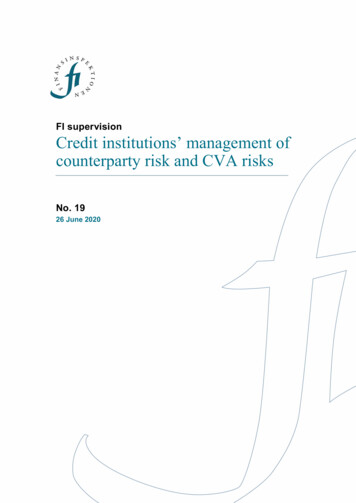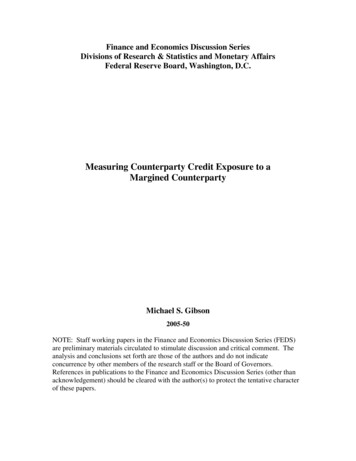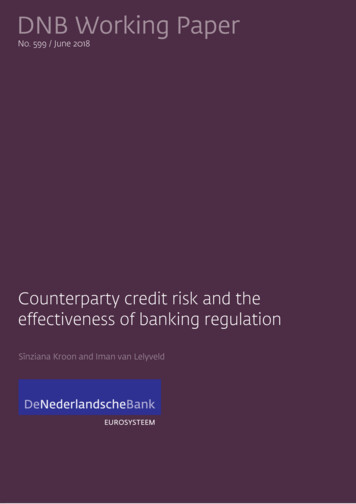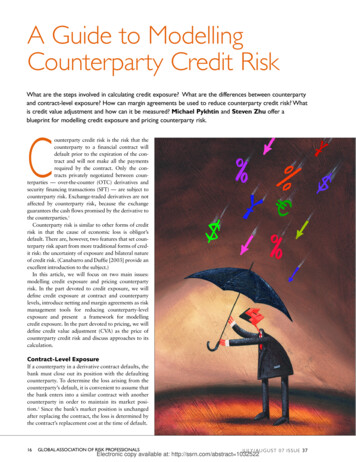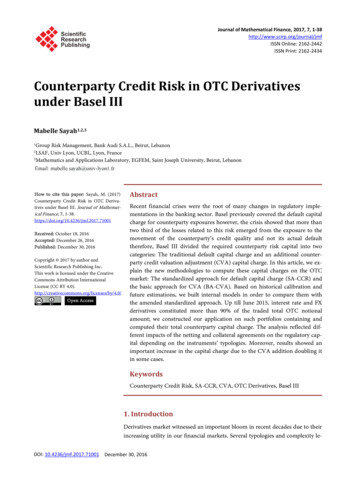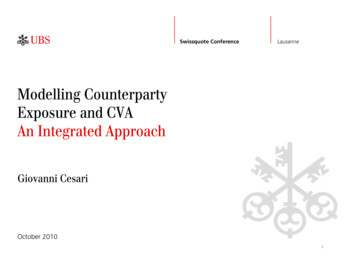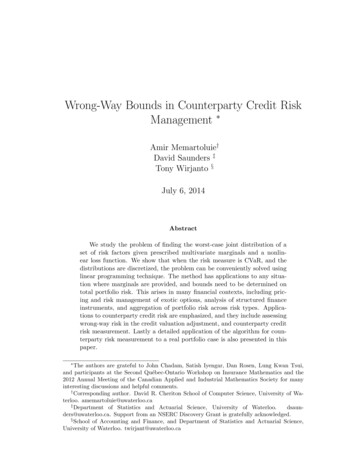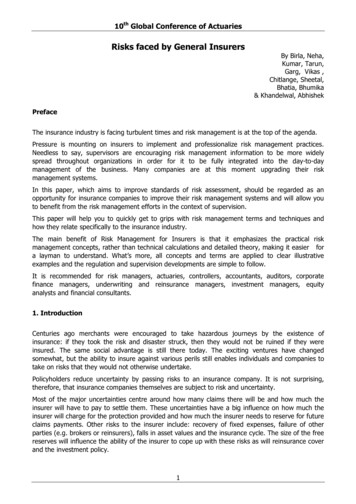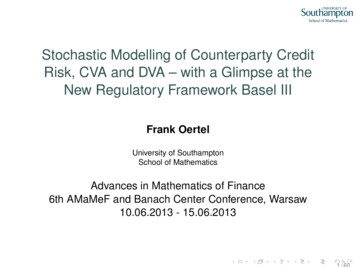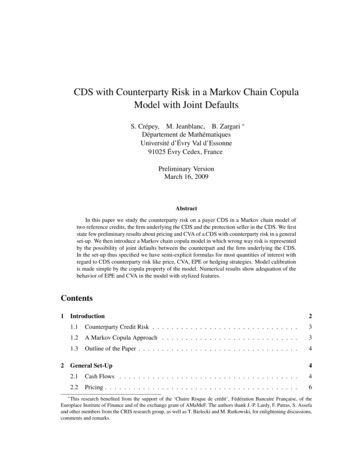
Transcription
CDS with Counterparty Risk in a Markov Chain CopulaModel with Joint DefaultsS. Crépey, M. Jeanblanc, B. Zargari Département de MathématiquesUniversité d’Évry Val d’Essonne91025 Évry Cedex, FrancePreliminary VersionMarch 16, 2009AbstractIn this paper we study the counterparty risk on a payer CDS in a Markov chain model oftwo reference credits, the firm underlying the CDS and the protection seller in the CDS. We firststate few preliminary results about pricing and CVA of a CDS with counterparty risk in a generalset-up. We then introduce a Markov chain copula model in which wrong way risk is representedby the possibility of joint defaults between the counterpart and the firm underlying the CDS.In the set-up thus specified we have semi-explicit formulas for most quantities of interest withregard to CDS counterparty risk like price, CVA, EPE or hedging strategies. Model calibrationis made simple by the copula property of the model. Numerical results show adequation of thebehavior of EPE and CVA in the model with stylized features.Contents12Introduction21.1Counterparty Credit Risk . . . . . . . . . . . . . . . . . . . . . . . . . . . . . . .31.2A Markov Copula Approach . . . . . . . . . . . . . . . . . . . . . . . . . . . . .31.3Outline of the Paper . . . . . . . . . . . . . . . . . . . . . . . . . . . . . . . . . .4General Set-Up42.1Cash Flows . . . . . . . . . . . . . . . . . . . . . . . . . . . . . . . . . . . . . .42.2Pricing . . . . . . . . . . . . . . . . . . . . . . . . . . . . . . . . . . . . . . . . .6 This research benefited from the support of the ‘Chaire Risque de crédit’, Fédération Bancaire Française, of theEuroplace Institute of Finance and of the exchange grant of AMaMeF. The authors thank J.-P. Lardy, F. Patras, S. Assefaand other members from the CRIS research group, as well as T. Bielecki and M. Rutkowski, for enlightening discussions,comments and remarks.
2CDS WITH COUNTERPARTY RISK2.33493.1Factor Process Model . . . . . . . . . . . . . . . . . . . . . . . . . . . . . . . . .93.2Pricing . . . . . . . . . . . . . . . . . . . . . . . . . . . . . . . . . . . . . . . . .123.3Hedging . . . . . . . . . . . . . . . . . . . . . . . . . . . . . . . . . . . . . . . .173.3.1Price Dynamics . . . . . . . . . . . . . . . . . . . . . . . . . . . . . . . .173.3.2Min-Variance Hedging . . . . . . . . . . . . . . . . . . . . . . . . . . . .17Implementation184.1Model Specification . . . . . . . . . . . . . . . . . . . . . . . . . . . . . . . . . .184.1.1Calibration Issues . . . . . . . . . . . . . . . . . . . . . . . . . . . . . . .194.1.2Case of constant coefficients . . . . . . . . . . . . . . . . . . . . . . . . .19Numerical Results . . . . . . . . . . . . . . . . . . . . . . . . . . . . . . . . . . .20Concluding Remarks and PerspectivesA Proof of Proposition 3.118Markov Copula Factor Set-Up4.25Special Case F H . . . . . . . . . . . . . . . . . . . . . . . . . . . . . . . . . .2424IntroductionSince the sub-prime crisis, counterparty risk is a crucial issue in connection with valuation and riskmanagement of credit derivatives. In general terms, counterparty risk is ‘the risk that a party to anOTC derivatives contract may fail to perform on its contractual obligations, causing losses to theother party’ (cf. Canabarro and Duffie [12]). A major issue in this regard is the so-called wrong wayrisk, namely the risk that the value of the contract be particularly high from the perspective of theother party at the moment of default of the counterparty. Classic examples of wrong way risk areselling a put option to a company on its own stock, or entering a forward contract in which oil isbought by an airline company (see Redon [20]).Among papers dealing with counterparty risk in general, one can mention, apart from the abovementioned references, Canabarro et al. [13], Zhu and Pykhtin [22], and the series of papers by Brigoet al. [8, 9, 10, 11]. From the point of view of measurement and management of counterparty risk,two important notions emerge: The Credit Value Adjustment process (CVA), which measures the depreciation of a contract dueto counterparty risk. So, in rough terms, CVAt Pt Πt , where Π and P denote the price processof a contract depending on whether one accounts or not for counterparty risk. The Expected Positive Exposure process (EPE), where EPEt is the risk-neutral expectation of theloss on a contract conditional on a default of the counterparty occurring at time t, which can berelated to the CVA by a suitable integral representations.
S. C RÉPEY, M. J EANBLANC AND B. Z ARGARI3Note that the CVA process can be interpreted as an option price process, so that counterparty riskcan, in principle, be dynamically managed.1.1Counterparty Credit RiskWrong way risk is particularly important in the case of credit derivatives transactions, at least fromthe perspective of a credit protection buyer, Indeed, via economic cycle and default contagion effects, the moment of default of a counterparty selling credit protection is typically a moment ofhigher value of credit protection.In a first attempt to deal with counterparty credit risk, we consider in this paper the problem ofvaluing and hedging a Credit Default Swap with counterparty risk (‘risky CDS’ in the sequel, asopposed to ‘risk-free CDS’, without counterparty risk). Note that this problem already received alot of attention in the literature. This admittedly specific problem can thus be considered as a benchmark problem of counterparty credit risk. To quote but a few: Huge and Lando [15] propose a rating-based approach, Hull and White [16] study this problem in the set-up of a static copula model, Jarrow and Yu [17] introduce an intensity contagion model, further considered in Leung and Kwok[18], Brigo and Chourdakis [8] work in the set-up of their Gaussian copula and CIR intensity model,extended to the issue of bilateral counterparty credit risk in Brigo and Capponi [7], Blanchet-Scalliet and Patras [6] or Lipton and Sepp [19] develop structural approaches.1.2A Markov Copula ApproachHere we consider a Markovian model of credit risk in which simultaneous defaults are possibleWrong way risk is thus represented in the model by the fact that at the time of default of the counterparty, there is a positive probability that the firm on which the CDS is written defaults too, inwhich case the loss due to counterparty risk is the loss given default of the firm, that is a very largeamount. Of course, this simple model should not be taken too literally. We are not claiming herethat simultaneous defaults can happen in actual practice. The rationale and financial interpretationof our model is rather that at the time of default of the counterparty, there is a positive probabilityof a high spreads environment, in which case, the value of the CDS for a protection buyer is close(if not equal) to the loss given default of the firm.A nice feature of a Markovian set-up such as the one we use here is that it is possible to addressin a dynamic and consistent ways the issues of valuing and hedging the CDS (and/or, if wished,the CVA, interpreted as an option as evoked above). More precisely, we shall be considering afour-state Markov Chain model of two obligors, so that all the computations are straightforward,either that there are explicit formulas for all the quantities of interest, or, in case less elementaryparameterizations of the model are used, that these quantities can be easily and quickly computedby solving numerically the related Kolmogorov ODEs.To make this even more practical, we shall work in a Markovian copula set-up (in the sense of Bielecki et al. [3]), in which calibration of the model marginals to the related CDS curves is straightforward (note that actual market CDS curves can be considered as ‘risk-free CDS curves’). The
4CDS WITH COUNTERPARTY RISKonly really free model parameters are thus the few dependence parameters, which can be calibratedor estimated in ways that we shall explain in the paper.1.3Outline of the PaperIn Section 2 we first describe the mechanism and cash flows of a (payer) CDS with counterpartycredit risk. We then state a few preliminary results about pricing and CVA of this CDS in a generalset-up. In Section 3 we introduce our Markov chain copula model. In the set-up thus specifiedwe are then able to derive explicit formulas for most quantities of interest in regard to a riskyCDS, like price, EPE, CVA or hedging strategies. Section 4 is about implementation of the model.Alternative model parameterizations and related calibration or estimation procedures are proposedand analyzed. Numerical results are presented and discussed, showing good agreement of model’sEPE and CVA with expected features. Finally Section 5 recapitulates our model’s main propertiesand presents some directions for possible extensions of the previous results in terms of models (with,possibly, spread volatility) and/or products (in view of integrating the CDS-CVA tool of this paperinto a real-life cross-products and markets CVA engine).The main results are Proposition 3.2, yielding the pricing formula for a risky CDS in our set-up,and Proposition 3.4, yielding the formulas for the related EPE and CVA.22.1General Set-UpCash FlowsAs is well known, a CDS contract involves three entities: A reference credit (firm), a buyer of defaultprotection on the firm, and a seller of default protection on the firm. The issue of counterparty riskon a CDS is: Primarily, the fact that the seller of protection may fail to pay the protection cash flows to thebuyer in case of a default of the firm; Also, the symmetric concern that the buyer may fail to pay the contractual CDS spread to theseller.We shall focus in this paper on the so-called unilateral counterparty credit risk involved in a payerCDS contract, namely the risk corresponding to the first bullet point above; however it should benoted that the approach of this paper could be extended to the issue of bilateral credit risk, in asuitably enriched version of the model (see the Introduction for various approaches to unilateralor bilateral CDS counterparty credit risk). With this in mind we shall find convenient to refer tothe buyer and the seller of protection on the firm as the (risk-free) investor and the (defaultable)counterpart, respectively. Indices 1 and 2 will refer to quantities related to the firm and to thecounterpart, first of which, the related default times τ1 and τ2 .Under a risky CDS, the investor pays to the counterpart a stream of premia with spread κ, or FeesCash Flows, from the inception date (time 0 henceforth) until the occurrence of a credit event(default of the counterpart or the firm) or the maturity T of the contract, whichever comes first.Let us denote by R1 and R2 the recovery of the firm and the counterpart, supposed to be adapted to
S. C RÉPEY, M. J EANBLANC AND B. Z ARGARI5the information available at time τ1 and τ2 , respectively. If the firm defaults prior to the expirationof the contract, the Protection Cash Flows paid by the counterpart to the investor depends on thesituation of the counterpart: If the counterpart is still alive, she can fully compensate the loss of investor, i.e., she pays (1 R1 )times the face value of the CDS to the investor; If the counterpart defaults at the same time as the firm (note that it is important to take this caseinto account in the perspective of the model with simultaneous defaults to be introduced later in thispaper), she will only be able to pay to the investor a fraction of this amount, namely R2 (1 R1 )times the face value of the CDS.Finally, there is a Close-Out Cash Flow which is associated to clearing the positions in the case ofearly default of the counterpart. As of today, CDSs are sold over-the-counter (OTC), meaning thatthe two parties have to negotiate and agree on the terms of the contract. In particular the two partiescan agree on one of the following three possibilities to exit (unwind) a trade: Termination: The contract is stopped after a terminal cash flow χ (positive or negative) has beenpaid to the investor. Offsetting: The counterpart takes the opposite protection position. This new contract should havevirtually the same terms as the original CDS except for the premium which is fixed at the prevailingmarket level, and for the tenor which is set at the remaining time to maturity of the original CDS.So the counterpart leaves the original transaction in place but effectively cancels out its economiceffect. Novation (or Assignment): The original CDS is assigned to a new counterpart, settling the amountof gain or loss with him. In this assignment the original counterpart (transferor), the new counterpart (transferee) and the investor agree to transfer all the rights and obligations of the transferor totransferee. So the transferor thereby ends his involvement in the contract and the investor thereafterdeals with the default risk of the transferee.In this paper we shall focus on termination. The amount χ is supposed to be adapted to the information available at time τ2 . For emphasizing this feature it is denote henceforth χ(τ2 ) . Moreprecisely, χ χ(τ2 ) should be computable at time τ2 according to a methodology specified in theCDS contract at inception. If the counterpart defaults in the life-time of the CDS while the firm isalive (τ2 τ1 T ), the value of χ(τ2 ) is calculated. If it is positive for the counterpart, she willbe paid fully by the investor and if it is negative for the counterpart, she will pay the investor just aportion R2 of it.Remark 2.1 A typical specification is χ(τ2 ) Pτ2 , where Pt is the value at time t of a riskfree CDS on the same reference name, with the same contractual maturity T and spread κ as theoriginal (risky) CDS. The consistency of this rather standard way of specifying χ(τ2 ) is, in a sense,questionable. Given a pricing model accounting for the major risks in the product at hand, including,if need be, counterparty credit risk, with related price process of the risky CDS denoted by Π, itcould be argued that a more consistent specification would be χ(τ2 ) Πτ2 (or χ(τ2 ) Πτ2 , sinceΠτ2 0 in view of the usual conventions regarding the definition of ex-dividend prices). Howeverwe shall see henceforth that, at least in the specific model of this paper, adopting either conventionmakes little difference in practice.
62.2CDS WITH COUNTERPARTY RISKPricingLet us be given a (risk-neutral) pricing model (Ω, F, P), where F (Ft )t [0,T ] is a given filtrationmaking the τi ’s stopping times, and with a related (adapted) discount factor process β. So in particular χ(τ2 ) is supposed to be an Fτ2 -measurable random variable. Let Et stands for the conditionalexpectation under P given Ft . We assume for simplicity that the face value of all the CDSs underconsideration (risky or not) is equal to monetary unit and that the spreads are paid continuously intime. All the cash flows and prices are considered from the perspective of the investor. In accordance with the usual convention regarding the definition of ex-dividend prices, all the integrals aretaken open on the left and closed on the right of the interval of integration. In view of the descriptionof the cash-flows in section 2.1, one then has, Definition 2.2 (i) The model (ex-dividend) price process of a risky CDS is given by Πt Et πT (t) ,where πT (t) corresponds to the risky CDS cumulative discounted cash flows on the time interval(t, T ], so,Z T τ1 τ2 βt πT (t) κβs ds βτ1 (1 R1 )11t τ1 T 11τ1 τ2 R2 11τ1 τ2t τ1 τ2 βτ2 11t τ2 T 11τ2 τ1 R2 χ (1)(τ2 ) χ(τ2 ) .(ii) The model (ex-dividend) price process of a risk-free CDS is given by Pt Et [pT (t)], wherepT (t) corresponds to the risk-free CDS cumulative discounted cash flows on the time interval (t, T ],so,Z T τ1βt pT (t) κβs ds (1 R1 )βτ1 11t τ1 T .(2)t τ1The first, second and third term on the right-hand side of (1) correspond to the fees, protection andclose-out cash flows of a risky CDS, respectively. Note that there are no cash flows of any kind aftertime τ1 τ2 T (in the case of the risky CDS) or τ1 T (in the case of the risk-free CDS).Remark 2.3 In these definitions it is implicitly assumed that, consistently with the usual theory ofno-arbitrage (see, e.g., Delbaen and Schachermayer [14]), a primary market of financial instruments(along with the risk-free asset β 1 ) has been defined, with price processes given as (locally bounded,say for simplicity) (Ω, F, P) – local martingales. No-arbitrage on the extended market consistingof the primary assets and a further CDS then results in the previous definitions. Since the precisespecification of the primary market is irrelevant until the question of hedging is dealt with, we leaveit for section 3.3.Let the Fτ2 -measurable random variable ξ(τ2 ) , interpreted as the loss incurred at τ2 due to counterparty risk, be given as (1 R1 )(1 R2 ), τ2 τ1 T,χ (1 R2 ),τ2 τ1 T,ξ(τ2 ) (3) (τ2 )0,otherwise .
7S. C RÉPEY, M. J EANBLANC AND B. Z ARGARIDefinition 2.4 (i) The Credit Valuation Adjustment (CVA) is the F-adapted process killed at τ1 τ2 T defined by, for t [0, T ], (4)βt CVAt 11{t τ1 τ2 } Et βτ2 ξ(τ2 ) .(ii) The Expected Positive Exposure (EPE) is the function of time defined by, for t [0, T ], EPE(t) E ξ(τ2 ) τ2 t .(5)Remark 2.5 Again the subscript (τ2 ) in ξ(τ2 ) emphasizes that ξ(τ2 ) is an Fτ2 -measurable randomvariable.Let Π0 denote Π in case χ(τ2 ) Pτ2 . The following Proposition justifies the name of CreditValuation Adjustment which is used for the CVA process defined by (4). This is essentially thebasic result that appears in the series of papers by Brigo et alii. Note that as opposed to Brigo et al.we do not exclude simultaneous defaults in our set-up, whence further terms in 11t τ1 τ2 T in theproof of Proposition 2.1.Proposition 2.1 CVAt Pt Π0t on {t τ2 }.Proof. If {τ1 t τ2 }, CVAt Pt Π0t 0. Assume t τ1 τ2 . Subtracting πT (t) from pT (t)yields,Zτ1 Tβt (pT (t) πT (t)) κβs ds βτ1 (1 R1 )11t τ1 T 11τ1 τ2τ1 τ2 T βτ1 R2 (1 R1 )11t τ1 T 11τ1 τ2 βτ2 11τ2 τ1 11τ2 T R2 χ (τ2 ) χ(τ2 ) ,(6)where the following identity was used in the second term on the right hand side of (6):11t τ1 T 11τ1 τ2 11t τ1 T 11τ2 τ1 11t τ1 τ2 T .Moreover, in view of (2), one has,Zβτ2 pT (τ2 )11τ2 τ1 11τ2 T κτ1 Tτ1 τ2 Tβs ds (1 R1 )βτ1 11τ2 τ1 T .(7)Plugging (7) into (6) , it comes,βt (pT (t) πT (t)) βτ2 11τ2 τ1 11τ2 T pT (τ2 ) βτ2 11τ2 τ1 11t τ1 T (1 R2 )(1 R1 ) βτ2 11τ2 τ1 11τ2 T R2 χ χ(τ2 )(τ2 ) .In case χ(τ2 ) Pτ2 one can then proceed as follows: On the set {τ2 τ1 },βt (pT (t) πT (t)) βτ2 pT (τ2 ) βτ2 R2 Pτ 2 Pτ 2
8CDS WITH COUNTERPARTY RISKAs Pτ2 Eτ2 [pT (τ2 )], we have βt Eτ2 pT (t) πT (t) βτ2 Pτ 2 (1 R2 ) .(8) On the set {τ1 τ2 },βt (pT (t) πT (t)) βτ2 (1 R1 )(1 R2 )and thus βt Eτ2 pT (t) πT (t) Eτ2 βτ2 (1 R1 )(1 R2 ) .(9)One thus has on the set t τ2 , using the fact that τ2 τ1 and τ2 τ1 are Fτ2 -measurable, βt Pt βt Π0t βt Et [pT (t)] βt Et [πT (t)] βt Et Eτ2 [pT (t) πT (t)]hi βt Et Eτ2 [pT (t) πT (t)]11τ2 τ1 Eτ2 [pT (t) πT (t)]11τ2 τ1 Et βτ2 χ(τ2 ) CVAt .22.3Special Case F HThe following proposition gathers a few useful results that can be established in the special case ofa model filtration F given as F FH : H (Ht )t [0,T ] , where H (H 1 , H 2 ) denotes the pairof the default indicator processes of the firm and the counterpart.Proposition 2.2 (i) For t [0, T ], any Ht -measurable random variable Yt can be written asYt y0 (t)11t τ1 τ2 y1 (t, τ1 )11τ1 t τ2 y2 (t, τ2 )11τ2 t τ1 y3 (t, τ1 , τ2 )11τ2 τ1 twhere y0 (t), y1 (t, u), y2 (t, v), y3 (t, u, v) are deterministic functions.(ii) For any random variable Z, one has,11t τ1 τ2 E(Z Ft ) 11t τ1 τ2E(Z11t τ1 τ2 ).P(t τ1 τ2 )(10)(iii) Πt Π(t, Ht ), for a pricing function Π defined on R E E with E {0, 1}, such thatΠ(t, e) 0 for e 6 (0, 0). In particular, Πt is given on the set t τ1 τ2 by a deterministicfunction E πT (t).(11)Π(t, 0, 0) u(t) : P(τ1 τ2 t)(iv) One has, for suitable functions χ̃(·) and CVA(·),1{τ2 τ1 } χ(τ2 ) 1{τ2 τ1 } χ̃(τ2 ) 1 , τ2 ) : (1 R2 ) (1 R1 )1τ τ T 1τ τ T χ̃ (τ2 )ξ(τ2 ) ξ(τ2121CVAt 11t τ1 τ2 CVA(t) .(12) (13)(14)
9S. C RÉPEY, M. J EANBLANC AND B. Z ARGARI(v) One has, for t [0, T ],ZTβs EPE(s)βt CVA(t) tP(τ2 ds)P(t τ1 τ2 )(15)Proof. (i) and (ii) are standard (see, e.g., [5]; (ii) in particular is the so-called Key Lemma).(iii) Since there are no cash flows of a risky CDS beyond the first default (cf. (1)), one has πT (t) πT (t)11t τ1 τ2 . The Key Lemma then yields, E πT (t)12Πt Et 11t τ1 τ2 πT (t) (1 Ht )(1 Ht )·P(τ1 τ2 t)Thus Πt Π(t, Ht1 , Ht2 ), for a pricing function Π defined byΠ(t, e1 , e2 ) (1 e1 )(1 e2 )u(t) ,where u(t) is defined by the right-hand-side in (11).(iv) follows directly from part (i), given the definitions of the random variable χ(τ2 ) and of the CVAprocess (see also (3) regarding (13)).(v) By (iv), one has, βt 1{t τ1 τ2 } CVA(t) 1{t τ1 τ2 } Et βτ2 ξ(τ2 )Z T 1 , s)1{τ ds} 1{t τ1 τ2 } Et βτ2 ξ(τ1 , τ2 ) 1{t τ1 τ2 }βs Et ξ(τ2t Z TZ T E ξ(τ1 , s)1{τ2 ds} 1{t τ1 τ2 }P(τ2 ds) 1{t τ1 τ2 }βs EPE(s), 1{t τ1 τ2 }βsP(t τ1 τ2 )P(t τ1 τ2 )ttwhich is (15).33.12Markov Copula Factor Set-UpFactor Process ModelWe shall now introduce a suitable Markovian Copula Model for the pair of default indicator processes H (H 1 , H 2 ) of the firm and the counterpart. The name ‘Markovian Copula’ refers tothe fact that the model will have prescribed marginals for the laws of H 1 and H 2 , respectively (seeBielecki et al. [2, 3] for a general theory). The practical interest of a Markovian copula model isclear with respect to the task of model calibration, since the copula property allows one to decouplethe calibration of the marginal and of the dependence parameters in the model (see section 4.1).More fundamentally, the opinion developed in this paper is that it is also a virtue for a model to‘take the right inputs to generate the right outputs’, namely taking as basic inputs the individualdefault probabilities (individual CDS curves), which correspond to the more reliable information onthe market, and are then ‘coupled together’ in a suitable way (see section 4.1).An apparent shortcoming of the Markov copula approach is that it is not compatible with defaultcontagion effects in the usual sense (default of a name impacting the default intensities of the other
10CDS WITH COUNTERPARTY RISKones). However, we shall be able to introduce dependence between τ1 and τ2 into the model byrelaxing the standard assumption of no simultaneous defaults. As we shall see, allowing for simultaneous defaults is a powerful way of modeling defaults dependence.Specifically, we model the pair H (H 1 , H 2 ) as an inhomogeneous Markov chain relative toits own filtration H on (Ω, H, P), with state space E {(0, 0), (1, 0), (0, 1), (1, 1)}, and matrixgenerator at time t given by the following 4 4 matrix A(t), where the first to fourth rows (orcolumns) correspond to the four possible states (0, 0), (1, 0), (0, 1) and (1, 1) of Ht : l(t) l1 (t)l2 (t) l3 (t) 2 (t)2 (t) 0 q0q A(t) (16) .11 0 0 q(t)q(t) 0000In (16) the l’s and q’s denote deterministic functions of time integrable over [0, T ], with in particularl(t) l1 (t) l2 (t) l3 (t).Remark 3.1 The intuitive meaning of ‘(16) being the matrix-generator of H’ is the following (see,e.g., Rogers and Williams [21] for standard definitions and results on Markov Chains): First line: Conditional on the pair Ht (Ht1 , Ht2 ) being in state (0, 0) (firm and counterpart stillalive at time t), there is a probability l1 (t)dt, resp. l2 (t)dt, resp.resp. l3 (t)dt, of a default of thefirm alone, resp. of the counterpart alone, resp.resp. of a simultaneous default of the firm and thecounterpart, in the next infinitesimal time interval (t, t dt); Second line: Conditional on the pair Ht (Ht1 , Ht2 ) being in state (1, 0) (firm defaulted butcounterpart still alive at time t), there is a probability q 2 (t)dt of a further default of the counterpartin the time interval (t, t dt); Third line: Conditional on the pair Ht (Ht1 , Ht2 ) being in state (0, 1) (firm still alive butcounterpart i default at time t), there is a probability q 1 (t)dt of a further default of the firm in thetime interval (t, t dt).On each line the diagonal term is then set as minus the sum of the non-diagonal terms, so that thesum of the elements in each line be equal to zero, as should be for A(t) to represent the generatorof a Markov process.Moreover, for the sake of the desired Markov copula property (Proposition 3.1(v) below), we impose the following relations between the l’s and the q’s.Assumption 3.2 q 1 (t) l1 (t) l3 (t) , q 2 (t) l2 (t) l3 (t).Observe that in virtue of these relations, Conditional on Ht1 being in state 0, and whatever the state of Ht2 may be (that is, in the state (0, 0)as in the state (0, 1) for Ht ), there is a probability q 1 (t)dt of a default of the firm (alone or jointlywith the counterpart) in the next time interval (t, t dt); Conditional on Ht2 being in state 0, and whatever the state of Ht1 may be (that is, in the states(0, 0) or (1, 0) for Ht ), there is a probability q 2 (t)dt of a default of the counterpart (alone or jointlywith the firm) in the next time interval (t, t dt).
11S. C RÉPEY, M. J EANBLANC AND B. Z ARGARIIn mathematical terms, it is thus expected that the default indicator processes H 1 and H 2 be HMarkov processes on the state space E {0, 1} with time t generators respectively given by"#"#1 (t) q 1 (t)2 (t) q 2 (t) q qA1 (t) , A2 (t) .(17)0000To formalize the previous statements, and in view of the study of simultaneous jumps, let us furtherintroduce the processes H {1} , H {2} and H {1,2} standing for the indicator processes of a default ofthe firm alone, of the counterpart alone, and of a simultaneous default of the firm and the counterpart,respectively. SoXXX{1}{2}{1,2}Ht 11 Hs (1,0) , Ht 11 Hs (0,1) , Ht 11 Hs (1,1) ,(18)0 s t0 s t0 s tor, equivalently,{1}Ht{2} 11τ1 t,τ1 6 τ2 , Ht{1,2} 11τ2 t,τ1 6 τ2 , Ht 11τ1 τ2 t .We denote I {{1}, {2}, {1, 2}}. The proof of tThe following Proposition is deferred to AppendixA.Proposition 3.1 (i) H 1 H {1} H {1,2} , H 2 H {2} H {1,2} ,(ii) The natural filtration of (H ι )ι I is equal to H,(iii) The H-intensity of H ι is of the form q ι (t, Ht ) for a suitable function q ι (t, e) for every ι I,namely, q {1} (t, e) 1e1 0 1e2 0 l1 (t) 1e2 1 q 1 (t) q {2} (t, e) 1e2 0 1e1 0 l2 (t) 1e1 1 q 2 (t)q {1,2} (t, e) 1e (0,0) l3 (t) .Otherwise said, the processes M ι defined by, for every ι I,Z tMtι Htι q ι (s, Hs )ds ,(19)0withq {1} (t, Ht ) (1 Ht1 ) (1 Ht2 )l1 (t) Ht2 q 1 (t) q {2} (t, Ht ) (1 Ht2 ) (1 Ht1 )l2 (t) Ht1 q 2 (t) (20)q {1,2} (t, Ht ) (1 Ht1 )(1 Ht2 )l3 (t) ,are H-martingales.(iv) The H-intensity process of H i is given by (1 Hti )q i (t). Otherwise said, the processes M idefined by, for i 1, 2,Z tiiMt Ht (1 Hsi )q i (s)ds(21)0
12CDS WITH COUNTERPARTY RISKare H-martingales.(v) The processes H 1 and H 2 are H-Markov processes with matrix-generator at time t given byA1 (t) and A2 (t) (cf. (17)).(vi) One has, for s t,P(τ1 s, τ2 t) e Rs0l(u)du eRtsq 2 (u)du, P(τ1 t, τ2 s) e Rs0l(u)du eRtsq 1 (u)du(22)and thereforeP(τ1 t) e Rt0q 1 (u)du, P(τ2 t) e P(τ1 s, τ2 dt) qt2 e Rs0l(u)du eRtsRt0q 2 (u)duq 2 (u)du, P(τ1 dt, τ2 s) qt1 e RtP(τ1 t, τ2 dt) qt2 e 0 l(u)du , P(τ1 dt, τ2 t) qt1 e Z t P(τ1 τ2 t) exp l(u)du .Rt0Rs0l(u)du eRtsq 1 (u)dul(u)du(23)0(vii) The correlation of Ht1 and Ht2 isρ(t) r exp R t 30 l (s)ds 1 R .t 2t 1exp 0 q (s)ds 10 q (s)ds 1exp R(24) Remark 3.3 In the Markov copula [3] terminology, the so-called consistency condition is satisfied(H 1 and H 2 are H-Markov processes, see the Proposition 5.1 of [3]). The bi-variate model H withgenerator A is thus a Markovian copula model with marginal generators A1 and A2 .3.2PricingWe use the notation of Proposition 2.2, which applies here since we are in the special case F H.Recall in particular Πt Π(t, Ht ) (1 Ht1 )(1 Ht2 )u(t), for a pricing function Π(t, 0, 0) u(t),as well as the identities (12), (14) (15).We assume henceforth for simplicity that, Rt The discount factor writes βt exp( 0 r(s)ds), for a deterministic short-term interest-ratefunction r, The recovery rates R1 and R2 are constant.Proposition 3.2 The pricing function u(t) of the risky CDS solves the following pricing ODE,(u(T ) 0dudt (t)(25) (r(t) l(t))u(t) π(t) 0 , t [0, T )where we set π(s) (1 R1 ) l1 (s) R2 l3 (s) l2 (s) R2 χ̃(s) χ̃(s) κ .(26)
13S. C RÉPEY, M. J EANBLANC AND B. Z ARGARISoTZβt u(t) βs e Rstl(u)duπ(s)ds .(27)tProof. Recall (11): E πT (t)u(t) ,P (τ1 τ2 t)where the denominator is given by Proposition 3.1(vi). For computing the numerator, let us rewritethe expressions for the cumulative discounted Fee, Protection and Close-out cash flows in terms ofintegrals with respect to H {1} , H {2} and H {1,2} , as follows:TZβs (1 Hs1 )(1 Hs2 )dsFees Cash Flow κ0ZTProtection Cash Flow (1 R1 )βs (1 2Hs )dHs{1} R2 (1 R1 )0ZTZβs dHs{1,2}0T (1 R1 )2βs (1 Hs )dMs{1} (1 R1 )ZTβs (1 Hs2 )q {1} (s, Hs )ds00ZTβs dMs{1,2}TZ R2 (1 R1 ) R2 (1 R1 )βs q {1,2} (s, Hs )ds00Z T 1Close-out Cash Flow βs R2 χ̃(s) χ̃(s) (1 Hs )dHs{2}0TZ 1βs R2 χ̃(s) χ̃(s) (1 Hs )dMs{2}0TZ βs R2 χ̃(s) χ̃(s) (1 Hs1 )q {2} (s, Hs )ds0Taking care of the martingale property of M {1} , M {2} and M {1,2} and of the fact that the integralsof bounded predictable p
The Credit Value Adjustment process (CVA), which measures the depreciation of a contract due to counterparty risk. So, in rough terms, CVA t P t t;where and Pdenote the price process of a contract depending on whether one accounts or not for counterparty risk. The Expected Positive Exposure process (EPE), where EPE
